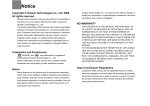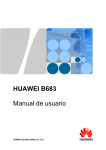Download Ariesys ARP 970-B User guide
Transcript
Wonderful Communication, Mobile Life. Welcome to HUAWEI 3G Wireless Gateway. HUAWEI 3G Wireless Gateway User Guide Copyright © 2008 Huawei Technologies Co., Ltd. All Rights Reserved No part of this manual may be reproduced or transmitted in any form or by any means without prior written consent of Huawei Technologies Co., Ltd. Trademarks and HUAWEI are trademarks of Huawei Technologies Co., Ltd. All other trademarks and trade names mentioned in this manual are the property of their respective holders. Notice The information in this manual is subject to change without notice. Every effort has been made in the preparation of this manual to ensure accuracy of the contents, but all statements, information, and recommendations in this manual do not constitute the warranty of any kind, expressed or implied. Safety Precautions Read the safety precautions carefully to ensure the correct and safe use of your wireless device. For detailed information, see "Warnings and Precautions." Do not switch on your device when the device use is prohibited or when the device use may cause interference or danger. Do not use your device while driving. Follow the rules or regulations in hospitals and health care facilities. Switch off your device near medical apparatus. Switch off your device in an aircraft. The device may cause interference to control signals of the aircraft. Switch off your device near high-precision electronic devices. The device may affect the performance of these devices. Do not attempt to disassemble your device or its accessories. Only qualified personnel are allowed to service or repair the device. Do not place your device or its accessories in containers with strong electromagnetic field. Do not place magnetic storage media near your device. Radiation from the device may erase the information stored on them. Do not put your device in a high-temperature place or use it in a place with flammable gas such as a gas station. Keep your device and its accessories away from children. Do not allow children to use your device without guidance. Use approved accessories only to avoid explosion. Observe the laws or regulations on device use. Respect others’ privacy and legal rights when using your device. Table of Contents 1 Using the Management Page ................................................................................................... 1 Logging in to the Management Page .............................................................................. 1 Management Page Overview........................................................................................... 1 Accessing the Internet...................................................................................................... 2 Viewing the Configuration Information ......................................................................... 3 2 Quick Setup .............................................................................................................................. 4 Configuring PPP Profile Settings .................................................................................... 4 Configuring PPP Dial-up Settings................................................................................... 4 Configuring WLAN Settings........................................................................................... 4 Configuring the WLAN Encryption Mode..................................................................... 5 Validating Quick Setup .................................................................................................... 6 3 Configuring Your Computer.................................................................................................... 7 Wireless Configuration .................................................................................................... 7 Configuring the PC Network ........................................................................................... 8 4 Advanced Settings Overview ................................................................................................ 11 5 System Management .............................................................................................................. 12 Changing the Password.................................................................................................. 12 Upgrading the device ..................................................................................................... 12 Restoring the Factory Defaults...................................................................................... 12 Restarting the Device ..................................................................................................... 13 Viewing the Version Information .................................................................................. 13 6 SIM/UIM Card Settings......................................................................................................... 14 Enabling or Disabling the PIN Code............................................................................. 14 Changing the PIN Code ................................................................................................. 14 Auto Validating PIN Code ............................................................................................. 14 7 Mobile Network Settings....................................................................................................... 15 Setting the Preferred Mode and Band ........................................................................... 15 Configuring the Mode for Searching Network............................................................. 15 8 Dial-up Settings...................................................................................................................... 16 Configuring the PPP Settings ........................................................................................ 16 i Managing the Profile List .............................................................................................. 16 9 DHCP Settings........................................................................................................................ 18 10 WLAN Settings.................................................................................................................... 19 Enabling or Disabling the WLAN................................................................................. 19 WLAN Basic Settings.................................................................................................... 19 WLAN Advance Settings .............................................................................................. 20 Configuring the MAC Filter .......................................................................................... 20 WLAN Bridge ................................................................................................................ 21 11 Security Settings (Optional) ................................................................................................ 22 Firewall Switch............................................................................................................... 22 LAN MAC Filter ............................................................................................................ 22 LAN IP Filter.................................................................................................................. 23 Virtual Server.................................................................................................................. 23 DMZ Settings ................................................................................................................. 24 UPnP Settings ................................................................................................................. 25 Remote Management ..................................................................................................... 25 12 Troubleshooting.................................................................................................................... 26 13 Warnings and Precautions.................................................................................................... 30 14 Abbreviations ....................................................................................................................... 33 ii 1 & Using the Management Page Note: The supported functions and displayed appearance are subject to your product purchased. Pictures posted for illustration purpose only. Please refer to the product for actual appearance. For details of your product selection, consult your service provider. Logging in to the Management Page 1. Start the Internet browser and enter the address http://192.168.1.1 in the address bar. 2. Select a user type, enter the password, and then click Login. Ÿ Admin: This user type is authorized to view and change the configurations. The default password is admin. Ÿ User: This user type is authorized to view only the basic status information. The default password is user. & Note: To avoid the configuration conflict, only one user is allowed to log in to the management page at a time. Management Page Overview Operation Functions The following table shows the main operations in the management page. Basic Status Item Description Displays the parameter configuration status of the device. Quick Setup Quickly configures the device. Connection Displays the network connection status and connects to the network. Advanced Settings Configures the advanced settings. Security Configures the security settings. 1 Item Description Logout Log out of the management page. Device Status The following table shows the status information of the device. Item Description SIM/UIM The SIM/UIM card is valid. The SIM/UIM card is not inserted or is invalid. WAN The PPP dial-up connection is successful. The PPP dial-up connection is failed. WCDMA The WCDMA network is connected. The WCDMA network is unavailable. & Note: If the device is registered with other network modes, the corresponding network connection status is displayed. SIG The signal strength from weak to strong is shown as follows: Accessing the Internet 1. & Click Connection. Note: Ÿ If you are required to enter the PIN code, enter the correct one. If you fail to enter the correct PIN or PUK code, the network-related functions are unavailable. Ÿ The SIM/UIM card is supplied by the service provider. For details, contact your service provider. Ÿ When the Save PIN Code check box is selected, the Auto validation of PIN code is enabled. Ÿ If Auto validation of PIN code is enabled, the PIN code is recorded and automatically validated after each reboot. 2. 2 If PPP Connection is Auto or On Demand, refresh the page to view the current network connection status. 3. 4. If PPP Connection is Manual, click Connect / Disconnect to connect to or disconnect from the network. Wait for several minutes, if you are prompted that the connection is successful, you can start the browser and enter the website address to access the Internet. Viewing the Configuration Information On the configuration page, you can view the current parameter configuration information and the network connection status. 1. 2. 3. Click Basic Status. Click Advanced on the right part of the page to view the advanced status. Click Refresh to view the current status on the advanced status page. 3 2 Quick Setup You can use the quick setup wizard to configure and maintain the basic parameters of the device. Click Quick Setup to access the welcome page. Click Next to configure the PPP profile settings. Configuring PPP Profile Settings Ÿ Profile Name: Enter a profile name when the text box is empty. Ÿ Dial-up Number/PPP User Name/PPP Password: Enter these three parameters provided by the internet service provider (ISP). The dial-up number is used to initiate the network call; the PPP user name and PPP password is used to obtain the service authorization provided by the ISP. Ÿ APN/IP Address: Select the mode for obtaining the access point name (APN) and IP address. If the carrier provides the relevant parameters, select Static and enter their values. Otherwise, select Dynamic and the device automatically obtains them. Configuring PPP Dial-up Settings PPP Connection: Select the dial-up access mode. Ÿ Auto: The device automatically connects to the Internet and does not disconnect when no data is transmitted. Ÿ On Demand: The device automatically connects to the Internet when data transmission exists. When the duration of no data transmission exceeds the maximum idle time, the device disconnects the Internet connection. Ÿ Manual: The device connects to the Internet after you click Connect on the connection page. For details, see "Accessing the Internet." PPP Authentication: This service is provided by your ISP. For details, consult your ISP. Configuring WLAN Settings (Name) SSID: Enter a name for your wireless local area network (WLAN). The service set identifier (SSID) is used to identify a WLAN. A PC and the wireless device can perform normal data communication only when they have the same SSIDs. To ensure the WLAN security, do not use the default SSID. You can enter a character string as the 4 SSID, such as MyHome. SSID Broadcast: Enable or disable the SSID broadcast. Ÿ Enabled: The device broadcasts the SSID of the WLAN and users can easily access the WLAN. In this case, unauthorized users can also access the WLAN because the SSID is broadcasted. Ÿ Disabled: The device does not broadcast the SSID of the WLAN. Before accessing the WLAN, a user must obtain the SSID of the WLAN. In this case, the WLAN security is improved. & Note: For the convenience of users accessing the WLAN, you can select Enabled for SSID Broadcast when you configure the WLAN setting. After the setting, you can select Disable to improve the WLAN security. Configuring the WLAN Encryption Mode To access the WLAN, you must set the wireless security key on your PC to be the same as that of the wireless device. No Encryption For the convenience of users accessing the WLAN, you can select NO ENCRYPTION for the Encryption mode when you set up a WLAN. It is not recommended to select this option in daily use. WPA-PSK/WPA2-PSK Ÿ WPA-PSK: It is a 256-bit data encryption method that can automatically change the key. Ÿ WPA2-PSK: It is a more secure version of WPA-PSK and it supports the IEEE 802.11 standard. Ÿ WPA Encryption Algorithm: TKIP, AES, TKIP+AES. Ÿ WPA Pre-Shared Key: You can enter a 64-character hexadecimal value or 8–63-character ASCII value as the key. The ASCII value contains all characters that can be entered through the PC keyboard, and the hexadecimal value contains numbers of 0–9 and characters of A–F. For example, you can enter the ASCII value of 1234abcde as the key. Ÿ Network Key Rotation Interval: It is used to set how long a network key is dynamically changed. By default, it is 0. To disable this function, you can set the value to 0 or null. WEP Wireless Equivalent Privacy (WEP) is a 64-bit or 128-bit data encryption method. The 128-bit WEP encryption provides higher security level. Network key 1: You can enter 5 ASCII characters or 10-character hexadecimal numeral to form a 64-bit key. You can also enter 13 ASCII characters or 26-character hexadecimal 5 numeral to form a 128-bit key. Validating Quick Setup The last page of the wizard displays all the settings you have configured. Ÿ To accept the settings, click Finish. Ÿ To change the settings, click Back.. Ÿ To quit the settings, click Cancel. 6 3 Configuring Your Computer This takes the Windows XP operating system (OS) as an example to describe how to configure your computer. For other OSs, the configurations may be different and you need to configure them as required. Wireless Configuration The wireless configuration allows your PC to connect to the device through the wireless network. If you need only the Ethernet to connect your PC, you can skip this part. Configuration Requirements Ÿ To set up wireless network connection, your PC must be configured with the WLAN adapter that supports the IEEE 802.11 b/g protocol. Ÿ If the encryption function is enabled, you need to ensure that all PCs connecting to the device use the same key as that of the device. Ÿ For the use of WLAN adapter, refer to the WLAN adapter user guide provided by the manufacturer. Ÿ For the encryption configurations, see "Configuring the WLAN Encryption Mode." Ÿ For SSID parameters configuration, see "Configuring WLAN Settings." Configuring the Wireless Network Connection 1. 2. 3. Choose Start > Control Panel > Network Connections > Wireless Network Connection. Click Show Wireless Networks to display the wireless network connection list. Select the network connection that the SSID is the same as that of the device, and then click Connect. 7 4. If the encryption parameter is set for the device, the Wireless Network Connection dialog box is displayed and requires the network key and confirmation. The value you entered must be the same as the WPA Pre-Shared Key or Network Key of the device. 5. Wait for a while after you enter the correct network key. The wireless connection icon displays in the status area in the lower right corner of the screen. Then, your PC can automatically connect to the device. Configuring the PC Network The recommended configurations of the PC are as follows: Ÿ Obtain an IP address automatically. Ÿ Deselect Use a proxy server for your LAN. 8 Configuring the Network Connection 1. 2. Choose My Network Places > Properties > Local Area Connection. Right-click the Local Area Connection icon and select Properties. 3. In the Local Area Connection Properties dialog box, select Internet Protocol (TCP/IP) in the This connection uses the following items list box, and then click Properties. 9 4. In the Internet Protocol (TCP/IP) Properties dialog box, select Obtain an IP address automatically and Obtain DNS server address automatically, and then click OK. Disabling Proxy Settings 1. 2. 3. 10 Start the IE browser, and then choose Tools > Internet Options. Select the Connections tab, and then click LAN Settings. In the LAN Settings dialog box, deselect Use a proxy server for your LAN. 4 Advanced Settings Overview Click Advanced Settings, you can configure both the basic attributes and advanced parameters of the device, and also perform routine maintenance and management to the device. The following table shows the functions of the shortcut icons. Icon Description Click to access the System page. Click to access the SIM/UIM card setting page. Click to access the Mobile Network Settings page. Click to access the Dial-up Settings page. Click to access the DHCP Settings page. Click to access the WLAN Settings page. 11 5 Click System Management to access the System page. Changing the Password You can change the login password to prevent unauthorized users from logging in to the management page. 1. 2. 3. Click . Enter the current password, and then enter the new password and confirm it. Click Modify. Upgrading the device 1. 2. 3. Click . Enter the path or click Browse to select the software image file to be updated. Click Upgrade. Caution: Ÿ After the system is upgraded, the system automatically restarts. The whole process takes two to three minutes. Ÿ The software programs for upgrading must come from the official website of Huawei or the official website of the carrier. Ÿ Upgrading the software does not change the configuration of the client. Restoring the Factory Defaults If you need to reconstruct the network or you forget the changes of some parameters, you can choose to restore factory defaults and reconfigure the device. Click 12 to access the Restore Defaults page, and then click Restore. & Note: After this operation, all configurations are restored to the defaults. Restarting the Device 1. 2. Click . Click Reboot. Viewing the Version Information Click to access the Version page. You can view the hardware version, software version, release time, and the hardware version and software version of the wireless module. 13 6 Click SIM/UIM Card Settings to access the SIM/UIM Setting page. When the device works in the ROM-SIM mode, the page is not available. Enabling or Disabling the PIN Code 1. 2. 3. 4. 5. Click . Select Enable/Disable in the PIN Code Operation list box. Enter the correct PIN code. Click Apply. If the PIN code is incorrect, the system prompts you to reset it. Changing the PIN Code When the PIN code protection is enabled, you can reset the PIN code. 1. 2. 3. 4. 5. Click . Select Modify in the PIN Code Operation list box. Enter the current PIN code. Enter the new PIN code and confirm it. Click Apply. Auto Validating PIN Code You can enable or disable the auto validate PIN code function. 1. 2. 3. 4. 14 Click . Select Enable/Disable in the Auto Validate option button. Enter the current PIN code. Click Apply. 7 Mobile Network Settings Click to access the Mobile Network Settings page, you can set the preference of the connection mode and band when the device searches a network. Setting the Preferred Mode and Band 1. 2. & 3. 4. Click . Select the preference of connection mode in the Preferred Mode list box. Note: Ÿ If the carrier provides only the 2G service and the preferred mode is configured as 3G only, you cannot access the Internet. Ÿ If the carrier provides only the 3G service and preferred mode is configured as 2G only, you cannot access the Internet. Ÿ If the carrier provides neither the 3G nor 2G service, you cannot access the Internet regardless of the preferred mode. Select the band to search the network in the Band list box. Click Apply. Configuring the Mode for Searching Network 1. Click . 2. Select the mode for searching the network. Ÿ Auto: The device automatically searches the network and registers with it. Ÿ Manual: You need to manually search the network and register with it. 3. Click Apply. 4. In Manual mode, select the searched network and click Log on. 15 8 Dial-up Settings Click to access the Dial-Up Settings page, you can configure the PPP settings and manage the profile settings. Configuring the PPP Settings 1. Click to access the PPP Settings page 2. Enter the correct parameters. Ÿ Profile List: Select a profile from the established dial-up connection list. If the drop-down list is empty, you need to create a profile list. Ÿ PPP Connection: Select the dial-up connection mode. Ÿ PPP Authentication: The service is provided by your ISP. For details, consult your ISP. Ÿ PPP Max Idle Time: The duration of the PPP connection is in idle. In On Demand mode, if no data is transmitted in this duration, the PPP connection automatically disconnects. Ÿ PPP MTU: It is the maximum transmission unit (MTU) of the PPP connection. It is used to set the maximum number of bytes encapsulated in a single data frame. Ÿ PPP Max Dial Time: Set the maximum waiting time when connecting to the Internet. Managing the Profile List Click to access the Profile settings page and you can create, edit, save, and delete a dial-up connection list. Creating a Profile 1. 2. Enter the profile information in the text box according to the prompts. Click Save. Changing a Profile 1. 16 Select a profile to be changed in the Profile List drop-down list. Relevant information is displayed in the corresponding text box. 2. 3. Enter the profile information. Click Save. Deleting a Profile 1. 2. Select a profile to be deleted in the Profile List drop-down list. Click Delete. 17 9 DHCP Settings Click to access the DHCP Setting page; you can set the mode for assigning IP addresses in a LAN. DHCP automatically assigns IP addresses to the network devices. If you are using the DHCP server, you need to do the configurations on the PC connecting with the device. For details, see "Configuring the PC Network". Ÿ IP Address: The default IP address of the device is 192.168.1.1. Ÿ Subnet Mask: The combination of the subnet mask and IP address enables the flexible subnetting. By default, the subnet mask is 255.255.255.0. Ÿ DHCP Server: It is used to assign IP addresses dynamically. If the DHCP server is Enabled, it can automatically assign IP addresses for PCs. It is recommended to select Disabled for the DHCP server. Ÿ Start IP Address/End IP Address: It is used to define the IP address range that the host can use during the IP address assignment. For example, in the network segment 192.168.1.0/24, the default IP address of the device is 192.168.1.1. The host IP address can range from 192.168.1.2 to 192.168.1.254. The minimum range is a single IP address. Ÿ DHCP Lease Time: The DHCP server automatically assigns an IP address to each device connected to the network. When the leased time expires, the DHCP server checks whether the device is connected to the network. If the device is disconnected from the network, the server assigns the IP address to another device. Thus, the IP address is not wasted. & Note: Ÿ The Start IP Address must be smaller than or equal to the End IP Address. Ÿ If the DHCP Server is Enabled, the configurations of Start IP Address, End IP address, and DHCP Lease Time are valid; otherwise, you cannot configure them. 18 10 Click WLAN Settings to access the WLAN Settings page. Enabling or Disabling the WLAN 1. 2. 3. Click to access the WLAN Enable page. Select Enable/Disable to enable or disable the WLAN. Click Apply. WLAN Basic Settings Click to access the WLAN Basic Settings page. Selecting Interface IDs Wireless Interface: It refers to the SSID and MAC address, and is used to identify the wireless device. SSID Ÿ Entering a name (SSID) for your WLAN. Ÿ Enabling or Disabling the SSID Broadcast Enabling or Disabling the AP Isolation Ÿ On: The terminals (PCs) connecting to the device through the WLAN cannot communicate with each other. Ÿ Off: The terminals (PCs) connecting to the device through the WLAN can communicate with each other. Selecting a Country Country: It is used to identify the country. Different countries have different standards on channel usage. 19 Selecting a WLAN Channel Channel: It refers to the channel that the device works with. If you do not know which channel to select, select Auto and the device can automatically search for the channel. Configuring the 802.11 Mode There are four available modes, as shown in the following table. Mode Description 54g Auto The WLAN has the best compatibility in this mode. 54g Performance The WLAN has the best performance in this mode. 54g LRS If the device has difficulties in communicating with devices conforming to the IEEE 802.11b standards, select this mode. 802.11b Only The device can only work in the low performance 802.11b standard network mode. Configuring the Transmission Rate 1. 2. Select Auto, the device automatically searches the transmission rate. Click Apply to submit the setting. WLAN Advance Settings Click to access the WLAN Advance Settings page. A security key can protect your WLAN from illegal data attacking. The security key of your wireless device must be consistent with that of the PC. Configuring the 802.11 Authentication Ÿ Open: Open system authentication. A user accessing the WLAN can choose WEP, WPA-PSK, or WPA2-PSK key to pass the authentication or choose No encryption to skip the authentication. Ÿ Shared: Shared key authentication. It can use only WEP. The user accessing the WLAN must use the WEP to authenticate. Configuring the Encryption Mode There are four encryption modes: No Encryption, WPA-PSK, WPA2-PSK, and WEP. For details, refer to "Configuring the WLAN Encryption Mode." Configuring the MAC Filter Click 20 to access the WLAN MAC Filter page. You can control and manage the clients accessing the WLAN, and improve the WLAN security performance. MAC Restrict Mode The following table shows the MAC address filter modes: Parameter Description Disabled The MAC address filter function is disabled. Allow The clients with addresses in the MAC Address list are allowed to connect with the device through the WLAN. Deny The clients with addresses in the MAC Address list are not allowed to connect with the device through the WLAN. MAC Addresses Enter MAC addresses in the list. The device can perform the access control over the clients whose MAC addresses are in the list. WLAN Bridge Click to access the WLAN Bridge page. Ÿ Preamble Type: It has two options: Long and Short. In the case that the client (PC) supports the Short type, the WLAN can have a better performance if it is Short. Ÿ MAX Associations Limit: It refers to the maximum number of connections. It is used to set the maximum number of concurrent WLAN users on the device. Ÿ Mode: It refers to the WLAN accessing mode. The device can work in two modes, as shown in the following table. The default value is Access Point. Mode Description Wireless Bridge It is used to connect two or more access points. Access Point The access points meeting the IEEE 802.11b/g standard or the wireless terminals can connect the wireless device. Ÿ Bridge Restriction: It refers to the limitation to the peer MAC addresses. When it is Disabled, the device can access all the remote bridges; when it is Enabled, the device can only access the remote bridges that the addresses are in the address list. Ÿ Bridges: It refers to the physical address of the remote peer bridge. The device supports the point-to-multipoint (PTM) bridge mode. Ÿ Peer MAC Address: It refers to the physical address list of the remote peer bridges. Ÿ Link Status: Up shows the successful connection and Down shows the failed connection. 21 11 Security Settings Click Security, you can configure the advanced security settings. Firewall Switch Your device has a true firewall that controls the incoming and outgoing data flow and protects your computer from illegal intrusion. 1. 2. & 3. Click . Select the Enable the firewall (main switch of the firewall) check box to enable the firewall. Note: Ÿ Only when the Enable the firewall check box is selected, the other functions such as the IP address filter function, the MAC address filter function, and the WAN port ping function are available. Ÿ When the Enable LAN MAC address filter check box is selected, the default filter rules are available. Select other options as required, and then click Apply. LAN MAC Filter Your device supports MAC filtering based on a list of either denied or allowed computers. A common method to restrict network access is to specify the Media Access Control (MAC) address. To locate the MAC address in the Windows OS, choose Start > Run, and then enter cmd. The command window is displayed, enter ipconfig /all, and then press Enter. The MAC address is displayed as the Physical Address. 1. 2. 3. 22 Click . Select MAC Filter Mode. Enter the MAC addresses of the clients and click Apply. LAN IP Filter You can configure the device to block the specific IP address from accessing the LAN. Click to access the LAN IP Filter page. Adding an IP Address 1. 2. 3. Select the protocol and status. Enter the IP address and corresponding port to be blocked from accessing the LAN. Click Ok. Changing an IP Address 1. 2. 3. Click in the Modification column. The corresponding IP address filter is displayed. Change the contents as required. Click Ok. Deleting an IP Address Click in the Modification column. The corresponding IP address filter is deleted. Validating an IP Filter 1. 2. 3. 4. Add a new IP address or select a record in the IP address filter table. Select On for Status. Click Ok. Click Apply. Virtual Server Your device supports the virtual server to enable external computers to access WWW, FTP, or other services provided by the LAN. Click to access the Virtual Server page. Adding a Virtual Server 1. Select the protocol and status. 23 2. Enter values in the following text boxes: Ÿ Name: Enter a name to the service provided by the LAN. Ÿ WAN Port: Enter the WAN port of the LAN in which the computer provides services. Ÿ IP Address: Specify a computer in the LAN to provide services. Ÿ LAN Port: Enter the LAN port of the computer that provides services. 3. Click Ok. You can also add a virtual server in the following way: 1. 2. 3. Select a port from the Common Port list. The Protocol, Status, Name, WAN Port, and LAN Port will be set as the default values. If required, you can change them. Enter the IP Address. Click Ok. Changing a Virtual Server 1. 2. 3. Click in the Modification column. The relevant virtual server is displayed. Change the contents as required. Click Ok. Deleting a Virtual Server Click in the Modification column. The corresponding virtual server is deleted. Validating a Virtual Server 1. 2. 3. 4. Add a virtual server or select a record in the virtual server table. Select On for Enabled. Click Ok. Click Apply. DMZ Settings If your PC cannot run network applications through the device, you can set the computer to access the Internet unlimitedly by configuring the IP address of the computer in the demilitarized zone (DMZ). However, the DMZ computer is not protected by the firewall. It is vulnerable to attack and may also put other computers in the home network at risk. 1. 2. 3. 4. 24 Click . Select Enabled /Disabled for DMZ Status to enable or disable the DMZ service. Enter the local IP address of the computer that is specified as a DMZ host. Click Apply. & Note: Only one computer can be specified as a DMZ host at a time. UPnP Settings The Universal Plug and Play (UPnP) service allows other network users to control your device’s network features to realize the intelligent interconnection. 1. 2. 3. Click . Select Enabled/Disabled for UPnP Status to enable or disable the UPnP service. Click Apply. Remote Management The remote web management allows the access and control of the device either from the home network or from the Internet. When you are on a trip, you can maintain your device through the remote web management service. It also allows your ISP to help you solve the device problems from a remote location. 1. 2. 3. 4. . Click Select Enabled or Disabled for Remote Status to enable or disable the service. Enter the IP address that can access and control your device. Click Apply. 25 12 Troubleshooting What to do if a PC in the LAN cannot access the Internet? 1. 2. 3. 4. 5. 6. 7. 8. The power indicator is on, and the device is normally connected with the power adapter. If the power indicator is off, you need to check whether the power adapter is normally connected. If the signal strength indicator is off, you need to check whether the area is covered by the network. If the area is covered by the network, you need to check whether the network mode is correct. For information about network mode, see "Mobile Network Settings" If the indicator of the Ethernet interfaces blinks, the corresponding Ethernet interface is normally connected. If the indicator is off, you need to check and ensure that the related Ethernet connection is normal. You must configure the correct PPP user name and PPP password when you access the Internet through the device. Check whether they are correct, and see "Configuring PPP Profile Settings" for details. If the DHCP service is disabled and the PC obtains the IP address dynamically, the PC also cannot access the Internet. You can change the mode to manually assign an IP address. See "Configuring the PC Network." Check whether the driver of the network adapter is correctly installed. If the preceding methods cannot solve the problem, you need to reset the device to factory defaults. What to do if a PC in the WLAN cannot access the WLAN? 1. 2. 3. 4. If interferences or shields near the device exist, you can adjust the position of the device. When the signal strength is strong, you can move to the next step. Check and record the following data on the PC's network adapter: SSID, WEP type, and key. Check and record the following data on the device: SSID, WEP type, and key. Compare the recorded data, the SSID on the network adapter should be ANY or be the same as that on the device. The WEP type and key on the network adapter and device should be the same. Otherwise, you need to change the data on the network adapter. What to do if I forgot the IP address of the LAN interface? If you forgot the IP address of the LAN interface, you can enter http://e.home and log in to the management page when the PC obtains the IP address automatically. 26 What to do if bridging between two devices is unsuccessful? 1. 2. Make sure that the two devices work on the same channel. For details, see "Selecting a WLAN Channel." Make sure that the MAC address of one device is in the peer MAC address list of the other device. For details, see "WLAN Bridge." When the signal strength is normal, what to do if the downloading rate is low? In this case, you need to set the value in the registry as follows: 1. 2. Choose Start > Run. Enter regedit in the Open text box and then click OK. 3. Select parameters in the following directory: \HKEY_LOCAL_MACHINE\SYSTEM\CurrentControlSet\Services\Tcpip. 4. Choose Edit > New > DWORD Value. 27 5. Rename New Value #1 to TcpWindowSize. 6. Right-click TcpWindowSize and then select Modify. 7. Select Decimal and enter 65535 in the Value data text box, and then click OK. 28 8. For the DWORD value of DefaultRcvWindow, do the same operations as that of TcpWindowSize. 29 13 Warnings and Precautions Electronic Device Ÿ Turn off your device near high-precision electronic devices. The wireless device may affect the performance of these devices. Ÿ Such devices include hearing aids, pacemakers, fire alarm systems, automatic gates, and other automatic-control devices can be affected. If you are using an electronic medical device, consult the device manufacturer to confirm whether the radio wave affects the operation of this device. Hospital Pay attention to the following points in hospitals or health care facilities: Ÿ Do not take your wireless device into the operating room (OR), intensive care unit (ICU), or coronary care unit (CCU). Ÿ Do not use your wireless device at places for medical treatment where wireless device use is prohibited. Traffic Safety Ÿ Please observe local laws and regulations on wireless device use. Do not use your wireless device while driving to avoid traffic accident. Ÿ Secure the wireless device on its holder. Do not place the wireless device on the seat or other places where it can get loose in a sudden stop or collision. Ÿ Use the wireless device after the vehicle stops at a safe place. Ÿ Do not place the wireless device over the air bag or in the air bag outspread area. Otherwise, the wireless device may hurt you owing to the strong force when the air bag inflates. Ÿ Observe the rules and regulations of airline companies. When boarding or approaching a plane, turn off the wireless device. In areas where wireless device use is prohibited, turn off the wireless device. Otherwise, the radio signal of the wireless device may disturb the plane control signals. Turn off your wireless device before boarding an aircraft. Storage Environment Ÿ Do not place magnetic storage media such as magnetic cards and floppy disks near the wireless device. Radiation from the wireless device may erase the information stored on them. 30 Ÿ Do not put your wireless device, and other accessories in containers with strong magnetic field, such as an induction cooker and a microwave oven. Otherwise, circuit failure, fire, or explosion may occur. Ÿ Do not leave your wireless device, and other accessories in a very hot or cold place. Otherwise, malfunction of the products, fire, or explosion may occur. Ÿ Do not place sharp metal objects such as pins near the earpiece. The earpiece may attract these objects and hurt you when you are using the wireless device. Ÿ Do not subject your wireless device, and other accessories to serious collision or shock. Otherwise, wireless device malfunction, overheat, fire, or explosion may occur. Ÿ Do not put your wireless device in the back pocket of your trousers or skirt to avoid wireless device damage while seated. Children Safety Ÿ Put your wireless device, and other accessories in places beyond the reach of children. Do not allow children to use the wireless device, or other accessories without guidance. Ÿ Do not allow children to touch the small fittings. Otherwise, suffocation or gullet jam can be caused if children swallow the small fittings. Operating Environment Ÿ The wireless device, and other accessories are not water-resistant. Keep them dry. Protect the wireless device, or other accessories from water or vapor. Do not touch the wireless device with a wet hand. Otherwise, short-circuit and malfunction of the product or electric shock may occur. Ÿ Do not use the wireless device in dusty, damp and dirty places or places with magnetic field. Otherwise, malfunction of the circuit may occur. Ÿ When carrying or using the wireless device, keep the wireless device at least 20 centimeters away from your body, to avoid negative impact on your health caused by radio frequency leakage. Ÿ On a thunder stormy day, do not use your wireless device outdoors or when it is being charged. Ÿ The wireless device may interfere with nearby TV sets, radios and PCs. Ÿ In accordance with international standards for radio frequency and radiation, use wireless device accessories approved by the manufacturer only. Cleaning and Maintenance Ÿ Before you clean or maintain the wireless device, turn off it and disconnect it from the power adapter. Otherwise, electric shock or short-circuit may occur. Ÿ Do not use any chemical detergent, powder, or other chemical agent (such as alcohol and benzene) to clean the wireless device and the other accessories. Otherwise, part damage or a fire can be caused. You can clean the wireless device and the other accessories with a piece of soft antistatic cloth that is a little wet. Ÿ Do not scratch the shell of the wireless device. Otherwise, the shed coating may cause skin allergy. Once it happens, stop using the wireless device at once and go to see a doctor. 31 Ÿ If the wireless device or any of its fittings does not work, turn to the local authorize service center for help. 32 14 3G Abbreviations The Third Generation A AC Alternating Current ARP Address Resolution Protocol AP Access Point APN Access Point Name C CDMA Code Division Multiple Access D DHCP Dynamic Host Configuration Protocol DNS Domain Name Server DL down link, downlink E EDGE Enhanced Data rates for GSM Evolution G GSM Global System for Mobile communications GPRS General Packet Radio Service GGSN Gateway GPRS Support Node H HSPA High Speed Packet Access HSDPA High Speed Downlink Packet Access HSUPA High Speed Uplink Packet Access HLR Home Location Register 33 I IP Internet Protocol ICMP Internet Control Message Protocol L LAN Local Area Network LED Light Emitting Diode L2TP Layer 2 Tunneling Protocol M MSC Mobile Switching Center N NAT Network Address Translation P PCS Personal communication systems PSTN Public Switched Telephone Network POTS Plain Old Telephone Service PPTP Point to Point Tunneling Protocol R RTT Radio Transmission Technology S SOHO Small Office Home Office SCP Service Control Point SGSN Serving GPRS Support Node SDRAM Synchronous Dynamic Random Access Memory T TKIP Temporal Key Integrity Protocol U UMTS Universal Mobile Telecommunications System UL up link, uplink V VLR 34 Visitor Location Register VPN Virtual Private Network W WAN Wide Area Network WLAN Wireless Local Area Network WCDMA Wideband CDMA WI-FI Wireless Fidelity Version: V100R001_02, English, Normal 35


















































